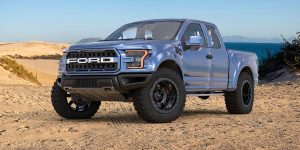The Ford F-150 has been around since 1948. It’s well-known for its ruggedness and versatility, making it an excellent pickup truck for farming, construction sites, and family vacations. However, there is so much more we can learn about this classic pickup.
Today, we’re going to take a look at all sorts of facts and stats about the Ford F-150, from its history to what’s going on with the latest 2023 model year.
Ford F150 Facts & Stats
- It only took 9 years for Ford to produce its first truck after Henry Ford put the average American on the road with the introduction of the Model T in 1917. The Model TT came in a few different flavors and could pull up to a ton of cargo. To be clear, it wasn’t a truck in the conventional sense. The TT’s foundation is a car chassis.
- During World War II, Ford halted the production of automobiles in order to reorganize its factories to support the war effort. However, the postwar boom was in full swing in 1948, and Ford introduced the F-Series of trucks at that time. For the American car industry, these innovations would be revolutionary. They were constructed on truck platforms rather than car chassis like their predecessors.
- During the ninth-generation Ford F150 in 1989, this classic pickup became the top-selling vehicle in all of the United States. It has retained its number-one spot for over 40 years.
- The sales for F-series trucks, including the F-150, amount to $17 billion more than all of Tesla.
- In 2022, Hennessey modified an F-150 to become the Hennessey VelociRaptor 6×6. It’s the most expensive Ford F-150 in the world, with a starting price of close to $400,000. It boasts over 600 HP of power, a 6WD drivetrain, and an elongated bed.
- To date, over 40 million Ford F-150s have been sold.
- Ford sold over 1,000,000 F-150s in 2018. On average, the company sold a single F-150 every 29.3 seconds, with an average hourly sale rate of more than 100.
- In Dearborn, Michigan, the Ford Truck Manufacturing Plan produces roughly 1,200 F-150s every 24 hours.
- The rear fenders of the narrow-box “stepside” bed were the longest-used part of any Ford F-series truck, appearing on the truck until 1979.
- One of the world’s largest cargo planes, the Russian Antonov An-124, with a lifting capacity of 150 tons and a wingspan of 240.5 feet, was used to transport 87,000 pounds of equipment to a factory in England after an F-150 production fire in May 2018. A pair of Boeing 737s parked side by side would not fill that space.
- In 2017, the sales of Ford F-Series trucks made more money than Facebook in the same year, selling close to 900,000 units.
- After a stock 2003 Ford SVT F-150 Lightning reached 147 miles per hour on Ford’s Arizona test track in August 2003, the vehicle was recognized as the “World’s Fastest Production Pickup” by the Guinness Book of World Records. While impressive, that speed is almost painfully slow compared to the 178.8 mph achieved by a modified, turbocharged 2002 Ford F-150 Lightning at the Texas Mile racing event in October 2016.
- Ford Performance engineers entered a street-legal 2017 Ford F-150 Raptor in the brutal Baja 1000 race in 2016, where many specially designed race trucks were destroyed. After placing third in the stock class, they filled it up with gas, washed it, and drove it more than 400 miles back to Ford’s testing center in Phoenix, Arizona, with the windows down and the air conditioning on.
- Walmart founder Sam Walton, who had amassed vast wealth by the time of his death in 1992, was still driving a brand-new Ford F-150 long wheelbase he purchased from the Bentonville dealership that is now McLarty Daniel Ford almost every day before he passed away.
- Walton didn’t live a fancy lifestyle, and when asked why one of the richest men in America would drive an everyday American truck, he famously responded with, “What am I supposed to haul my dogs around in, a Rolls-Royce?”
- The 2018 Ford F-150 is close to 700 pounds lighter than its predecessor because of the use of aerospace-grade aluminum alloy in the vehicle’s body panels and other components.
- As many as 58,203 2021-22 Ford F-150s were recalled due to heat and noise insulator issues brought about by the aluminum driveshaft.
- There were 896,526 sales of the F-Series in 2019. (the coronavirus pandemic disrupted the global supply chain and led to microchip shortages.) In comparison, 336,978 Toyota Camrys were sold, making it the best-selling car of the year (and probably every year). Ford sold 909,300 F-series trucks in 2018. In fact, the F-series surpassed the million mark in sales 4 times (including in 2004 when it sold 939,511 units).
- The 2021 Ford F-150 Lightning became the most affordable EV F-150 option of its time. It had a starting price tag of slightly under $40,000. However, due to supply chain issues, Ford has been forced to raise the price of the F-150 Lightning EV.
- The F-150’s unparalleled sales success can be attributed in part to the truck’s low price for a full-size pickup of its size, power, and dependability. The price for the base 2023 version is $33,695. The Raptor is one of eight models that can have their base prices increased to a maximum of $76,775. Prices for the 700 HP Raptor R begin at around $109,000 (including destination charges).
- The F-150 Lightning, an all-electric variant, packs a serious punch. The major electric utility in central and northern California, Pacific Gas & Electric, is collaborating with Ford to assess the truck’s potential to aid in the company’s efforts to restore power to city grids in the event of an outage. Because of its bidirectional charging capabilities, the F-150 can send power back to a house or other charging station.
- The Ford F-150 and other models in the F-Series got their name from their payload capacities. The discontinued F-100 could tow 1,000 pounds or half a ton, while the F-200 could tow an even 2,000 pounds. America’s favorite, the F-150, is smack-dab in the middle at ¾ of a ton or 1,500 pounds.
- The F-Series has been a workhorse in rough and demanding environments for decades. Ford introduced the Super Duty line of medium-duty trucks for commercial use in 1998, relegating the F-150 to light-duty use, effectively splitting the truck market into 2.
- The Ford GT and GT MK II, as well as the legendary Shelby Mustang family, are all products of Ford’s Performance Division, which is also responsible for the rest of the company’s high-performance vehicles. The F-150 Raptor, a ferocious beast of a truck, is part of that top-tier garage and racing squad. The 3.5-liter, 24-valve twin-turbo engine produces an impressive 450 horsepower.
- Since the first clumsy F-Series models were mass-produced, many improvements have been made to the F-Series line. As the F-100 was discontinued during the seventh generation (1980–1986), the F-150 became the industry’s lightest pickup truck. The previous generation F-150, which debuted in 2015, was able to lose 750 pounds thanks to the switch from a steel to an aluminum body. Considering that the frame is still fabricated from high-strength steel, which allows it to retain its durability, the weight reduction is particularly impressive.
Ford F150 Generation Years
-
- 1948 to 1952 (1st Generation)
- 1953 to 1956 (2nd Generation)
- 1957 to 1960 (3rd Generation)
- 1961 to 1966 (4th Generation)
- 1967 to 1072 (5th Generation)
- 1973 to 1979 (6th Generation)
- 1980 to 1986 (7th Generation)
- 1987 to 1991 (8th Generation)
- 1992 to 1997 (9th Generation)
- 1997 to 2004 (10th Generation)
- 2004 to 2008 (11th Generation)
- 2009 to 2014 (12th Generation)
- 2015 to 2020 (13th Generation)
- 2021 to Present (14th Generation)






